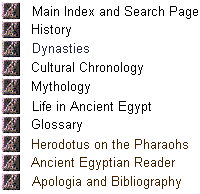
Printout
For best results save the whole webpage (pictures included) onto your hard disk, open the page with Word 97 or higher, edit if necessary and print.
Printing using the browser's print function is not recommended.
The religion of the people
Worship in the temples
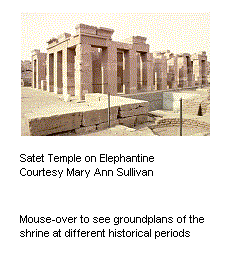 The vast temple complexes with their armies of priests and servants grew out of humble beginnings. The local population built a small mud-brick shrine for their own, local deity, chose priests out of their midst to serve it, and brought offerings in return for favours and protection. They expanded it slowly over the centuries by adding new wings but eventually the state began to administer them, investing resources larger than a single community was capable of and eventually replacing mud-brick structures by stone buildings [3].
The vast temple complexes with their armies of priests and servants grew out of humble beginnings. The local population built a small mud-brick shrine for their own, local deity, chose priests out of their midst to serve it, and brought offerings in return for favours and protection. They expanded it slowly over the centuries by adding new wings but eventually the state began to administer them, investing resources larger than a single community was capable of and eventually replacing mud-brick structures by stone buildings [3].The priests' role was not pastoral [4] and their contact with the believers was minimal. They were appointed from the scribal classes and many offices became hereditary while the role of the lay priests recruited from the general populace shrank and their importance was reduced. The control over the temples ceased to be in the hands of the community.
The involvement of the general public in the temple ceremonies was small. Ordinary people had no access to the inner regions of the temples which could only be entered after elaborate purification rituals. Offerings to the gods, food, flowers, or votive stelae, could be made in the outer temple courts. During the Ptolemaic Period believers paid for the mummification and storage of animals sacred to the gods. Hundreds of thousands of animals were especially reared and killed for this purpose.
The public encountered the statues of the gods only during processions when they left the temple precinct carried on the shoulders of their priests and became accessible to direct pleas from by-standers. In their role of oracles the gods gave simple yes/no answers to written questions, often deciding otherwise insoluble court cases.
These divine outings were generally occasions for popular celebrations, with pilgrims coming from afar to attend them [1]. Mystery plays or similar displays were performed at a few temples, with the spectators taking on parts of supernumeraries.
Serapis, a Hellenistic composite of Osiris and the bull Apis and always more popular with the Greeks than with native Egyptians, united aspects of Zeus, Helios, Hades, Asklepius and Dionysos and its cult attracted pilgrims from the whole Mediterranean world who left votive stelae in the vaults of the Serapeum in Alexandria.
The lack of intimate communion with the deity was offset to some extent by the divine statues in the temple parts accessible to the public which one could address and by the Hearing Ear shrines which some of the great temples instituted, places where worshippers could talk to the god directly. In a similar vein, offerings of ear stelae were hoped to influence the gods.
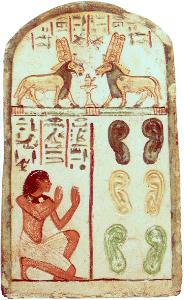
Ear stela of Bai
Source: Wilkinson: The Complete Gods and Goddesses of Ancient Egypt
You are Amun, the Lord of the silent,Ptah who hears prayer had such a shrine at Medinet Habu. Hathor, Re, Thoth and Horus could also be approached in a similar fashion. Some people may have preferred to address themselves to deified human go-betweens like Imhotep of whom was said: You see Amun in the seasons' feasts, for your seat is next to his, or Amenhotep son of Hapu who promised: People of Thebes who wish to see Amun: come to me and I will transmit your petitions.
Who comes at the voice of the poor;
When I call to you in my distress,
You (5) come to rescue me,
To give breath to him who is wretched,
To rescue me from bondage.
You are Amen-Re, Lord of Thebes,
Who rescues him who is in dat;
For you are he who is [merciful],
When one appeals to you,
You are he who comes from afar.
Stela of Nebre
M. Lichtheim Ancient Egyptian Literature, Vol. II, p.105f
Many of the temple services concerned matters generally far removed from the hearts of the ordinary Egyptian: he was little touched by the great matters of world order as long as the local scribes he depended on could be lived with, the fate of past pharaohs so often remembered in the temples regarded him little, though he followed similar rituals to make certain of his own immortality, and he probably implicitly relied on the effectiveness of the priests' efforts to ensure the continued daily rebirth of the sun.
Personal piety
The Egyptians saw themselves and their world beset by dangers. Major threats like the destruction of the sun were countered by the ceremonies performed in the temples by the king and his substitutes, the priests. Every-day disasters of a personal kind were caused by demons and had to be countered by addressing oneself to the appropriate deity using prayer, bringing them offerings and conjuring them with magic.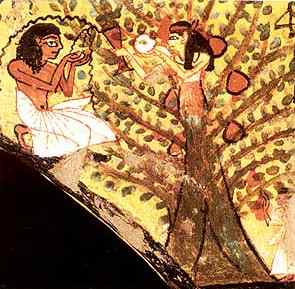 A great many different gods were invoked. A small number among them were hoped to protect believers under most circumstances, others were called upon on special occasions only.
A great many different gods were invoked. A small number among them were hoped to protect believers under most circumstances, others were called upon on special occasions only.
Offerings to a tree goddess
Tomb of Padehu
Some gods had special affinities with certain groups of people. The name of Hauron, the divine herdsman, would probably quite often be on the tongues of herdsmen, repeating spells for the protection of their cattle against wild animals. Ptah, as one of the gods who hear prayers, could be addressed by anybody, but being the patron of crafts he was more likely to be in the mind of a tradesman than a peasant. Thoth was venerated especially by scribes, who could read the spells to invoke him, but his amulets in ibis or baboon shape were worn commonly. The goddess of the pyramidal peak, Meretseger, was worshipped by workers of royal necropoles until the end of the New Kingdom when the great tomb works were finally abandoned. Travellers were protected by Amen who possibly carried a statuette of the god as Amen of the Road.
Gods of plenty
The well-being of Egypt depended on the Nile. Many people wore amulets of Khnum, the controller of the Nile. Hapi, a god without a temple of his own, was worshipped publicly all over the country during an annual festival where hymns and paeans were sung in his honour.Mistress of the Granary and Mistress of Fertile Fields were two of Renenut's names, and she was closely associated with the Nile god Hapi.
I shall make Hapy gush for you,Peasants built small shrines in vineyards and fields to thank the Snake who Nourishes, for her bounty. Called Thermouthis by the Greeks, she was venerated as a Christian saint after the suppression of the ancient Egyptian religion.
No year of lack and want anywhere,
Plants will grow weighed down by their fruit;
With Renutet ordering all,
All things are supplied in millions!Famine Stela
M. Lichtheim Ancient Egyptian Literature, Vol. III, p.99
Household deities
While a great deal is known about the official religion and rituals, the religious usages of the Egyptian people are not as well documented. They seem to have worshiped some gods in their homes, possibly by placing little offerings in front of divine statuettes. In the front rooms of the workers' houses at Deir el Medina there were raised platforms which may have served as altars [2].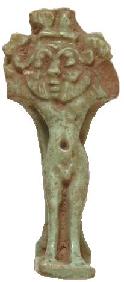 Bes and Taweret were two of the main household gods. Pictures of these protective deities were painted on the walls of the houses, their statuettes were placed in niches from which they could keep an eye on their charges, and amulets hung around people's necks. Head-rests and legs of beds were carved in their shape to protect sleepers at night when they were at their most vulnerable. Music was associated with the gods. Bes was sometimes shown playing the cymbals, and there were dances performed in his honour where the dancers dressed up like the god.
Bes and Taweret were two of the main household gods. Pictures of these protective deities were painted on the walls of the houses, their statuettes were placed in niches from which they could keep an eye on their charges, and amulets hung around people's necks. Head-rests and legs of beds were carved in their shape to protect sleepers at night when they were at their most vulnerable. Music was associated with the gods. Bes was sometimes shown playing the cymbals, and there were dances performed in his honour where the dancers dressed up like the god.
Amulet with the body of Horus, the head of Bes, and the tail of Theoris, Late Period
Source: Petrie Museum website, UC10862
Shed, the Rescuer, a god not enjoying much formal worship, was venerated as a protector. Khepri had the form of the dung-beetle which seemingly came into being out of nothing and symbolized the rising sun. Scarabs became the most widespread kind of amulet in the Near East, and was vital as heart scarab in protecting the heart of the dead, without which no eternal life was possible. Mut had many votive stelae and amulets dedicated to her as the protective Great Mother.
Fertility and childbirth
Procreation was of vital importance and, given the high mortality rate, a great number of births was desirable, as was the birth of at least one male child who, as the eldest son, was to perform the rites assuring his parents' immortality.Nut could help women when her depiction in the shape of a sow, sometimes with suckling piglets, was worn as an amulet. The bull Serapis and the ithyphallic god Min to whom the lettuce, supposedly an aphrodisiac, was dedicated, came to the assistance of men.
Childbirth was a critical time when Hathor, Nekhbet, Khnum, Bes, and others were invoked to come to the birthmother's and the newborn's assistance.
Illness
Against diseases whose origins were mostly explained as the pernicious influences of demons, one could wear protective amulets of Horus, and, if the demons had overcome these defenses, the god might still be able to help in one's getting better: healing plaques invoking his powers have been found. The power of the gods was used to evict the demons from the ailing person rather than to kill them, as the remains of the dead spirits might be deleterious themselves.Babi, a fierce baboon god, was conjured up in healing spells, as was Imhotep, a deified commoner of the 3rd dynasty, who was identified with Asklepius, the Greek god of medicine in the Late and Graeco-Roman Periods.
 Offerings of mummified ibises, and models of injured limbs and ailing organs served to remind the god of what needed healing. Both Mafdet and Shu were invoked to act against demons. Shu's "poisons" counteracted demonic power and Mafdet was supposed to combat the influence of a demon whose name was written on a loaf in the shape of a phallus wrapped in fatty meat and given to a cat to eat.
Offerings of mummified ibises, and models of injured limbs and ailing organs served to remind the god of what needed healing. Both Mafdet and Shu were invoked to act against demons. Shu's "poisons" counteracted demonic power and Mafdet was supposed to combat the influence of a demon whose name was written on a loaf in the shape of a phallus wrapped in fatty meat and given to a cat to eat.
Stings and bites
Cobra amulet, Amarna
Source: Petrie Museum website, item UC1168
Unlucky days
There were in the Egyptian calendar a number of days which were considered unlucky. The Egyptian year lasted 365 days and was divided into 12 months of thirty days each, leaving five intercalary days. These epagomenes the birthdays of the gods Osiris, Isis, Nephtys, Seth and Horus were generally considered inauspicious, and amulets of Bastet in the form of cats and kittens were worn as protection.Justice
While the pharaonic justice system served the needs of society fairly well most of the time, individuals caught up in it might feel pretty much lost and at the mercy of officials who did not share their social background and lacked understanding for the predicament they were in. There were no lawyers to explain moot points of law, and a great deal of the proceedings must have appeared rather arbitrary to them. They might therefore have been tempted to present their case before a temple oracle such as Mut's or use magical spells invoking Re, threatening to interrupt the sun's journey through the sky.Amen was the 'state' god of New Kingdom Egypt, responsible for the upholding of Maat, the divine world order, one of the main aspects of which was justice. Ramses II, surrounded by a multitude of Hittites, found fault with his god:
Then spake Pharaoh, and he cried:Amen whose priesthood controlled much of the economic and political life of the country since the New Kingdom, was also considered a champion of the downtrodden:
"Father Ammon, where are you?
Shall a sire forget his son?
Is there anything without your knowledge I have done?
From the judgments of your mouth when have I gone?
Have I e'er transgressed your word?
Disobeyed, or broke a vow?
Is it right, who rules in Egypt, Egypt's lord,
Should e'er before the foreign peoples bow,
Or own their rod?The Poem of Pentaur
Translated by W. K. Flinders Petrie
Amun, lend your ear to the lonely in court,But if people expected justice they also hoped for mercy. Stelae devoted to Meretseger, believed to punish criminals with blindness or poisonous insect stings, recorded her forgiveness.
He is poor, he is not rich;
For the court extorts from him:
"Silver and gold for the clerks,
Clothes for the attendants!"
Might Amun appear as the vizier,
To let the poor go free;
Might the poor appear as the justified,
And want surpass wealth!P. Anastasi II.8,5-9,1
M. Lichtheim Ancient Egyptian Literature, Vol. II, p.111
Afterlife
It is unclear what the afterlife held for a deceased commoner during the early dynastic age when the pharaohs began to develop elaborate rituals to ensure their own continued existence. His tomb was equipped with a few implements, knives, pots and the like, and his body was often naturally preserved in the warm, dry ground. Those who had been close to the king tried to get buried as near as possible to their overlord, seemingly looking for protection. By the New Kingdom anybody who could afford it - a small minority of the population - and whose life had been reasonably pious could build himself a tomb, furnish it with the necessary spells, have his body preserved and buried, and hope that the person entrusted with supplying mortuary offerings would not fail in his task.Osiris, ruler of the realm of the dead, invoked in many mortuary spells and protective texts, entered the realm of popular religion as the consort of Isis.In the guise of Serapis, originally in the form of a bull but increasingly depicted in human shape, he became known all over the Mediterranean and was venerated above all by non-Egyptians as protector and benefactor of the dead. The baboon-god Babi, too, if the healing spells invoking him had not had the desired effects, was hoped to protect the deceased in the afterlife.
While the body of the deceased slowly decayed in his tomb, his immortal twin, the ka, stood guard over him and shared with him the offerings relatives - above all the eldest son - brought to the grave, both in the hope of prolonging his life and of placating him. To the ancient Egyptians cemeteries were haunted places, and the dead might follow the living even into their own homes, sometimes with evil intent.
[1] According to Herodotus' Histories Vol.II
Moreover, it is true also that the Egyptians were the first of men who made solemn assemblies and processions and approaches to the temples, and from them the Hellenes have learnt them, and my evidence for this is that the Egyptian celebrations of these have been held from a very ancient time, whereas the Hellenic were introduced but lately. The Egyptians hold their solemn assemblies not once in the year but often, especially and with the greatest zeal and devotion at the city of Bubastis for Artemis (Bastet), and next at Busiris for Isis; for in this last-named city there is a very great temple of Isis, and this city stands in the middle of the Delta of Egypt; now Isis is in the tongue of the Hellenes Demeter: thirdly, they have a solemn assembly at the city of Sais for Athene, fourthly at Heliopolis for the Sun (Helios), fifthly at the city of Buto in honour of Leto, and sixthly at the city of Papremis for Ares.
Now, when they are coming to the city of Bubastis they do as follows: -they sail men and women together, and a great multitude of each sex in every boat; and some of the women have rattles and rattle with them, while some of the men play the flute during the whole time of the voyage, and the rest, both women and men, sing and clap their hands; and when as they sail they come opposite to any city on the way they bring the boat to land, and some of the women continue to do as I have said, others cry aloud and jeer at the women in that city, some dance, and some stand up and pull up their garments. This they do by every city along the river-bank; and when they come to Bubastis they hold festival celebrating great sacrifices, and more wine of grapes is consumed upon that festival than during the whole of the rest of the year. To this place (so say the natives) they come together year by year even to the number of seventy myriads of men and women, besides children.
[back]
[2] We should be wary to jump to conclusions concerning the general population based on what we know from Deir el Medina. In many respects this was a very special village: a New Kingdom community of workers and craftsmen, quite a large proportion of whom were literate, involved in the building of royal tombs - and very often their own private ones as well. They must have been much closer to an understanding of the official religious practices than the peasantry.
[back]
[3] The temple Senusret II built at Kahun still consisted mostly of bricks which were covered with stone, later removed by Ramses II. The New Kingdom saw the replacement of cheap bricks by expensive stone in many temples. The economic and social consequences these investments had and whether they eventually brought about the decline of the country are not easily evaluated.Thutmose III renovated the Ptah temple at Karnak
His majesty found this temple of brick /// /// he made this temple of sandstoneBrugsch, Thesaurus V, 1188
[back]
[4] The priesthood took care of the gods' and only to a small extent of the people's needs. The physical and social part of the latter was the domain of the 'civil' branch of the administration and its head, the pharaoh. The concept of protector of the people, of - in Seti I's words - the father and mother of all, of the herdsman who looks after his flock, is very old. One of the titles the pharaoh bore was that of the Good Shepherd
... the good shepherd, vigilant for all people, whom the maker thereof has placed under his authority...J.H. Breasted, Ancient Records of Egypt, Part Two, § 900
[back]